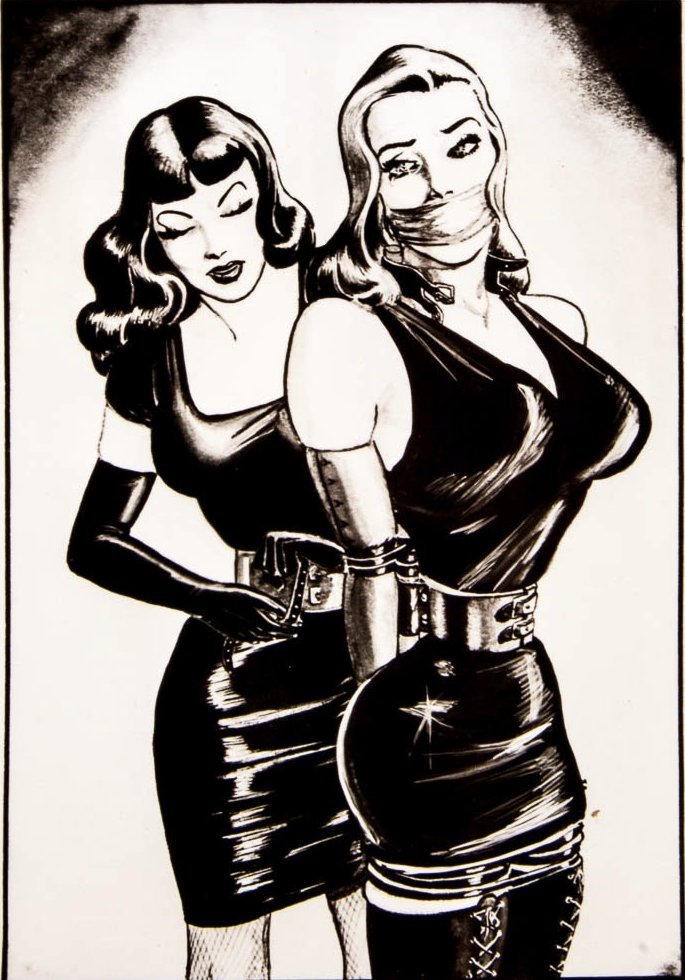What do Batman, Spiderman, Bettie Page, Madonna and women wrestlers have in common? Well I'll tell you: they all feature in the life of today's featured pulp artist!
Today I look back at the career of "the father of fetish" Eric Stanton...
Today I look back at the career of "the father of fetish" Eric Stanton...

Eric Stanton was born in New York in 1926. His childhood was marred by many illnesses, and confined to bed he learnt to draw by tracing comic books. He was fascinated by strong Amazonian women like Sheena, Queen of the Jungle and soon began creating similar cartoons. 

After high school Stanton joined the Navy in 1944, putting his skills to use in drawing aircraft recognition cartoons. Post-war he got a job with cartoonist Gordon 'Boody' Rogers, creator of Babe: Amazon Of The Ozarks. 

After reading some of pin-up publisher Irving Klaw's 'fighting girl comic strips' Stanton wrote to complain about their poor quality: "I can draw much better than most of your artists!" he boasted. Klaw wrote back challenging Stanton to do so. 

Stanton sent Klaw eight pages of detail drawings of high-heeled women wrestlers. Impressed, Klaw asked him to produce his own comic strip based on the idea. Stanton's "Women Wrestlers" launched in 1948. It would run for 10 years. 



Klaw provided Stanton with regular opportunities to produce fetish comic strips, sold through adverts in his magazines. However Stanton was paid poorly for his work and didn't retain copyright. He had to work other jobs to pay the bills. 

Then in 1954 Stanton began to study at the Cartoonist and Illustrators' School, under former Batman artist Jerry Robinson. He learnt how to lay out a comic book page to improve its impact and how to add more dynamism to his illustrations. 

As censorship laws began to relax, Stanton was asked to draw comics about a wider range of fetish themes for Klaw and others; crossdressing, bondage and dominant women. As these were 'only cartoons' he was able to explore themes that couldn't be published in other media. 



Stanton certainly loved the idea of Amazon women, and admitted that as a short and shy man he enjoyed the idea of big, strong, aggressive females. As a result he created the Tame-Azons strip, about powerful women who tame men. 

However by 1958 Stanton was in financial difficulties and his marriage was in trouble. He was also addicted to painkillers due to severe back pain from his work. He decided to part company with Irving Klaw, who continued to reprint his work without paying him. 

Stanton then shared a studio with old classmate Steve Ditko, co-creator of Spiderman and Doctor Strange. Ditko inked the cartoons and Stanton developed the themes. They enjoyed working together and found the fetish work they did both funny and creative. 

Stanton also produced over 300 colour covers for pulp books, usually for Stanley Malcolm. His distinctive style was beginning to become collectable, with original artwork being sold for several thousand dollars to collectors. Sadly Stanton saw very little of the money. 

Eric Stanton normally painted in watercolour and tempera, allowing him to finish a cover in a few hours. His style was very distinctive: elongated figures, strong colour contrasts and tight composition. 

Stanley Malcolm quit the pulp publishing business towards the end of the 1960s, as the market for erotic fiction was declining following relaxation of the censorship laws and the rise of more explicit adult magazines. However he did leave Stanton with a present... 

...his mailing list, allowing Stanton to contact almost 20,000 subscribers who wanted to see fetish cartoons. Stanton quickly launched a new magazine called Stantoons, with illustrations tailored to the specific needs of his new niche audience. 

By the 1970s Eric Stanton was staring to get recognition for his work, and would produce tailored commissions for collectors. He also developed new cartoon characters riffing on popular culture, such as Blunder Broad - a BDSM Wonder Woman parody. 



And by the 1990s Eric Stanton was finally recognised as a pioneer of fetish art: Madonna paid homage to his work and Taschen issued a retrospective collection of his illustrations. However it was late recognition: Stanton sadly passed away in March 1999. 

Eric Stanton - along with Gene Bilbrew - pioneered a strong, dominant female aesthetic in the 1950s which has stood the test of time. It may seem tame by today's standards but his vision of the modern Amazon is still highly influential.
More stories another time...
More stories another time...

• • •
Missing some Tweet in this thread? You can try to
force a refresh























